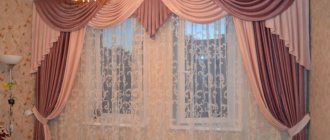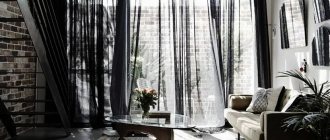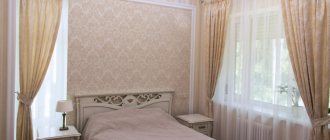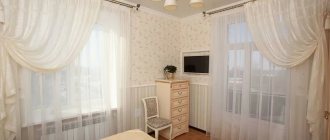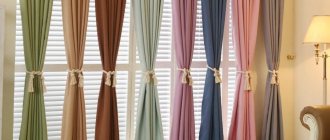The elegant design of the top part of the curtains is called a lambrequin. Platbands made of metal or wood on windows and roofs of buildings are also called lambrequins.
The decor on the windows performs 4 functions:
- adjusting the window shape;
- decorating a window indoors;
- adjusting room lighting;
- helps hide the cornice.
Window decoration in the living room Source ratatum.com
The first lambrequins began to appear in the Renaissance, but initially they were used to decorate beds in the form of over-bed canopies. Later, windows began to be decorated with fabric with embroidery or fringe.
Curtains with lambrequin for the living room Source indizajn.ru
Over time and the emergence of new styles, the appearance of curtains with lambrequins changed. Now they are acquiring the features of luxury; ribbons, gold elements, and massive drapery began to appear on them. Over time, the palette of colors used and the variety of fabrics expanded.
Today you can easily make curtains with lambrequins of various shapes and colors for the living room.
Lambrequin with tie and frill Source dizayndoma.com
In mustard color Source www.pinterest.com
Cozy window sill Source rerooms.ru
Dark curtains with lambrequin Source rulon.net.ua
Functions of lambrequins for the hall and living room
Having completed the renovation, many come to the conclusion that the old drapes or curtains are outdated and it’s time to change something. When choosing a style of curtains for a business room in a house, it is important to decide whether it will be a short curtain, a wide-format curtain or a lambrequin for a room without curtains. Beautiful tulle with side blinders and a carved addition in the center looks most elegant.
A rigid lambrequin is mounted on a ceiling baguette or a special strip, performing several functions:
- fills the space between the ceiling and the window opening;
- balances the proportions of the curtain composition;
- hides the fastening of multi-layer window decoration;
- determines the style in interior design;
- limits sunlight in the upper third of the window;
- harmonizes the aesthetics of the room.
Important! When choosing the style of lambrequins, it is important to have a sense of proportion so that the room does not look like Madame Pompadour’s boudoir or a provincial restaurant.
Multi-level curtains with a lambrequin in the living room should not be too pretentious. When they try to add palace chic to a modern interior, repeating the style of a bygone era, it will look tasteless.
The easiest way to track fashion trends in curtain design is through online catalogs and original proposals from design studios that produce window compositions. This is the best way to find out what fashionable curtains with a lambrequin for the hall should look like for 2022 - 2022.
We hang the canvas on a tubular cornice
The reversible lambrequin can be fixed to the tubular cornice using hooks. We throw the loose ends of the material over the crossbar and beautifully drape the lambrequin with curtains.
The lambrequin is usually the third and final element, which is placed on top of airy translucent tulle and heavy curtain material. Designers often recommend using a one-piece tubular structure, so it must be strong enough to support the weight of these curtains. It is advisable to weigh each layer onto a separate cornice strip. This will allow you to easily move the fabric and have access to the window. It is advisable to fix the cornice as high as possible, right under the ceiling. You can choose any length - for the entire wall or just the width of the window. Here you just need to take into account the nuance of proper installation. A short cornice is always attached only to 2 brackets, which are located at the edges. For a long one, you definitely need to make a third fastening element right in the middle. This is necessary for the safety of residents, as well as to avoid sagging of the material and breakage of the plank. Regular hooks, rings or clips are not suitable for lambrequins. Its fasteners must completely cover the cornice, so strong Velcro is used that can withstand the weight of even very heavy curtains.
Which fabric to choose for DIY sewing?
The interior textile market is represented by a variety of options from natural, synthetic and mixed fibers. Any curtain design studio gives preference to smooth, plain fabrics that look expensive.
Beautiful curtains with a lambrequin for the hall do not always have to be made of the same material. If the material of the curtains is heavy and rigid, then it is better to sew soft swags and interceptions from satin in the color of the curtains, decorating them with light drapery.
Cheap synthetics with metallized thread are no longer relevant. The most popular are double-sided jacquard fabrics, where a single-color pattern is formed from a special weave of threads. Such curtains have a matte pattern on a glossy background, but vice versa on the inside. Such fabric will not be able to form soft folds and scallops.
Rigid materials - for a wide strip with counter or bow folds. They hold well the ironed decorative elements of the part - a mold or “tie”, as in the example of a new lambrequin in a small room.
For a lambrequin with soft scallops of the “awning” type, soft silk fabrics are suitable. High-quality thin linen also drape well, but it has the disadvantage of being very wrinkled after washing. But there is a flax reaper that does not require ironing after the next wash.
Expensive panne velvet and iridescent plush are rarely seen in modern catalogs today. It was replaced with inexpensive but high-quality velor, which is also suitable for making beautiful lambrequins for the hall or living room yourself. But even a simple plain fabric will look good when complemented with luxurious accessories - fringe, tassels, silk ribbons and cords.
Curtain materials
Since the lack of light creates heaviness, curtains are expected to be as light as possible. Here you should not place bulky curtains made of heavy fabric, which will take away the coziness of the room. On the contrary, you need to pay attention to something airy.
For example, for tulle you can use organza, veil or tulle mesh with large cells. A good option for decoration would be a muslin curtain, which consists of threads fastened at the top. Options with plastic beads look especially attractive.
When planning to make small night curtains with your own hands, you should give preference to linen and cotton. These fabrics transmit light well and at the same time hide well what is happening inside the apartment.
When decorating a small window, you can use silk, taffeta, satin, jacquard or blackout. The glossy shine of satin will help highlight the individual elements of the curtain. However, its excess will cause the opposite effect.
Asymmetrical options
When choosing a curtain design, it is important to take into account the style of the interior and the practicality of the style. If beautiful decor prevents you from curtaining the curtain opposite the balcony door or wide transom, you will have to look for a way to solve the problem:
- abandon a multi-layer composition with a lushly draped lambrequin;
- choose an asymmetrical style;
- move the cornice with window decoration forward so that the doors do not come into contact with the fabrics.
- place a symmetrical version of the curtains on a special cornice that swings open towards itself.
For rooms with a balcony door, asymmetrical lambrequin patterns are suitable. Such models are quite functional and convenient, especially if you often have to go out onto a loggia or balcony.
A beveled bottom, asymmetry, decor with a soft interception on one side - all these methods are appropriate where you have to abandon symmetrical classic curtains.
Types of hard
The structures are made using different techniques. They are often a factory-made product, but sometimes they are also made at home.
Openwork
The simplest option is an openwork stripe. Sometimes an intricate pattern is cut into it using a laser. In this case, the drawing can be made in any style. Such lambrequins are made from lace, denser fabric, incl. felt.
With a straight, curly edge
Basically we are talking about strip, or strip, lambrequins. Such models can be hung even in rooms with low ceiling heights. They are often made from coupon roll material, with a pattern repeated along the entire length.
Cut the products in the form of 2 rectangles of the same length, leaving seam allowances on each. Separately, cut out a rectangle from cushioning material - doublerin or non-woven fabric with an adhesive base, which will help fix the rigid shape. Such lambrequins do not form folds.
In addition, there are plank structures made of rolled material with a curved edge - they look impressive.
Combined lambrequins
With classic styles, we found out that it is important to decide on the style and suitable fabric. But what to do if you want to combine curtains and tulle with a lambrequin for a hall where different types of decor would be combined? Such models also exist.
Designers have long thought out all the asymmetrical and traditional variations, which combine a rigid template with holes into which panels of soft fabric are inserted.
Note! It is generally difficult to choose any model of lambrequins under the blinds so that such a duet is harmoniously perceived in the interior. If you want to hide the attachment of the entire structure to the cornice, it is better to replace it with a wide wooden baguette or a ceiling strip for baguette tape.
Complex, layered designs serve multiple functions, including balancing the proportions of a room. Complex models are often chosen to draw attention to the window decoration.
This is justified in cases where there is no stylistic connection to the interior, and window textiles dictate the overall mood. A selection of photos of lambrequins for the hall shows how to create something unusual with your own hands from ordinary fabric.
Types of soft
In the interior of residential premises, soft curtains are often used. There are many varieties of them, and it is easy for owners to choose the most suitable option.
Swags
They are semicircular parts assembled into slightly sagging drapery elements. They are attached to the cornice using curtain tape, which makes it easier to assemble the folds.
Swags are used in interiors decorated in a classical style; they are not suitable for minimalism.
Step-by-step sewing of a swag looks like this:
- First they take measurements. You need to know the width and height of the window opening, the length of the cornice.
- Make a calculation. For swag, such indicators as depth (the degree of sagging of the drapery), length (the segment that the product will occupy on the cornice), shoulder (side part) are important. The most popular are equilateral swags, both arms of which are the same length.
- They build a swag pattern taking into account its shape. For an equilateral element, the pattern is made based on a square.
- Cut out the product blank, taking into account seam allowances.
- The parts of the swag are sewn together taking into account the characteristics of the fabric from which it is made.
Tie
This element is also called déjabot, or frill. It is a vertical drapery of a spiral shape. This lambrequin resembles an old tie that can be seen in historical portraits. It can be cascading or helical, with counter folds. "Ties" can be combined with swags.
Coquille
The element is often associated with women's dresses or blouses, but lambrequins can also have this shape. This is a strongly flared circle or oval, which is cut out in a spiral, carefully working out the edges. Both single and double molds look beautiful.
Buffs
The window decor element is a piece of fabric that forms three-dimensional assemblies of various shapes. They are secured using hand or machine stitching.
Bell
This is not a full-fledged lambrequin, but a detail of window decoration - a small element with draperies reminiscent of a bell.
Window decoration in a country house
Considering that village houses are built in such a way that it is almost impossible to peek out of the window due to the distance from the road or a high fence, thick curtains are rarely required here.
Therefore, the window can be decorated with tulle, which will optimally fit into classic or Provence. And these styles, often used to decorate rustic houses, give the premises a special charm.
Therefore, although a small window imposes a number of restrictions on the choice of curtains, it leaves room for imagination. And it is not an obstacle to creating a cozy interior.
Note!
- How to choose the right TV
- Which gender is better to choose?
- Options for interior partitions
Choosing curtains for a small window opening in the kitchen
When choosing curtains for a small kitchen, it is important to first think about practicality. Here the textiles are affected by fumes from pots and pans on the stove. In addition, the material may become contaminated with food or drinks.
Therefore, it is better to use fabrics that are easy to wash. For example, fabrics made of synthetic fibers impregnated with compounds that repel water and dirt. Such curtains will be easy to wash and dry quickly.
In addition to traditional curtains, you can use Roman or roller blinds. They don't overload the space. And when rolled up, the risk of contamination is reduced.
If a window requires a curtain with greater light transmission, you can opt for tulle in white or pastel colors. The material practically does not absorb light, but does not completely cover the imperfections of the window.
Note!
- Which heating is better to choose?
- Which wallpaper is better to choose
- Which cuisine is better to choose?
And he doesn’t hide it from prying eyes in the evenings. Therefore, this option is used in rooms where a small window opening is combined with an exit to the north side.
Features of the color scheme
To adjust the window opening, you need to choose the right color. It is believed that the curtains here should be the same tone or slightly lighter than the wallpaper. This creates a natural effect.
At the same time, it is allowed that the design of such a room is based on a play of contrasts. For example, a combination of dark curtains with light walls is used. Or warm shades are contrasted with cold ones. However, caution and judgment must be exercised when planning such experiments. Otherwise you can end up with chaos.
Drawing plays a corrective role. If you do not want to use a plain curtain, you should give preference to a large pattern. Moreover, if the window is not high enough, you need to use a pattern with vertical stripes. If the opening is too narrow, you need the pattern to visually expand it.
Note!
DIY ottoman: examples of new products and modern design (120 photo ideas)
- Small dressing room
- Storage room in the apartment
